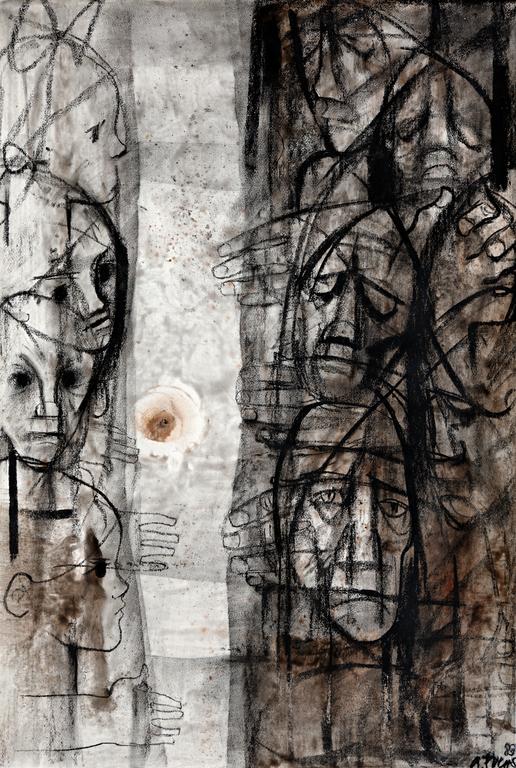Alfred Fuchs: Zyklus „Antikriegszeichnungen“ (Anti-war drawings)

Chalk and charcoal drawings, here: "Gesichter” (Faces), 68 x 97 cm
Three anti-war drawings by Alfred Fuchs stand in stark contrast to the idyll he conjured up in his other two series, "Kinderleben" (Child’s Universe) and "Landschaften, Städte und Dörfer" (Landscapes, Towns and Villages; works from these series can also be seen at the academy). The style and theme of these illustrations are a world away from the cheerful serenity and colorfulness that characterize his other paintings. The color black dominates in "Immer dasselbe” (Always the Same, 1985), "Gesichter” (Faces, 1983) and "Ohne Titel” (Untitled). They show emaciated faces and gazes from which life and joy have disappeared. Prisoners in the darkness, who in one picture have the luring and unreachable key to their cell before their eyes. Or who, as in this picture entitled "Gesichter” (Faces), are next to helpful people who are also unreachable. Alfred Fuchs (*1925 in Saarbrücken, Germany, †2003 in Prague, Czech Republic) knew exactly what he was drawing there - from personal experience:
He was born the second of three children of a Jewish father and a Christian mother. In October 1935 the family moved from Saarbrücken to Prague. Their hopes of escaping Nazi terror were not fulfilled. Although the family survived, they were deeply affected by the experiences of flight, social ostracism, separation and imprisonment. The trace of his paternal grandmother had been lost in an extermination camp in the east. In the summer of 1943, the Gestapo arrested Alfred Fuchs' older brother Wilhelm, who had been active as a courier in a resistance group (Gestapo = Geheime Staatspolizei, the so-called "political police" for the prosecution of political crimes during the National Socialist era). In the summer of the same year, Alfred was deported as a "half-breed" to a "Labour camp for half-breed Aryans" near the village of Bystrice. Shortly thereafter, his father, then 55 years old, was deported to Theresienstadt concentration camp, either already the final stop or a transit camp for Czechoslovakian Jews to the even larger extermination camps. In spite of all the misfortune, a miracle did happen: After the end of the war, the male members of the Fuchs family returned home - to Prague.
Alfred Fuchs' art takes an unambiguous stance against war and oppression and calls for humanity. The viewer is also touched by his "Mother and Child" drawings - albeit in a completely different way. Alfred Fuchs deals with his longing for a carefree childhood as well as the loss of his little sister Adele. She arrived in Scotland on one of the Kindertransports (Literally: Child transports, Refugee Children's Movement), which allowed Jewish children to leave the German Reich for the UK in 1938/1939. There, she found a new home but after the war she remained a stranger to her biological family. She had survived, but the Fuchs family had nevertheless lost their daughter.
Alfred Fuchs can be assigned to contemporary figurative painting, but also works with elements of the Impressionists. In 1993, he exhibited together with Jaroslav Vaček, a Czech sculptor and friend of his, who is also represented with several works at the academy. Fuchs has always remained closely associated with the Europäische Akademie Otzenhausen, donated 39 paintings and has been its only honorary member since 1998.
Sabine Graf’s book "Unter der Kerze ist Schatten" about Alfred Fuchs' life, which the academy published in 2005, is available here.